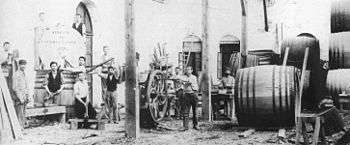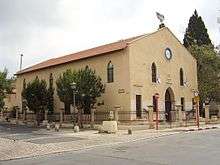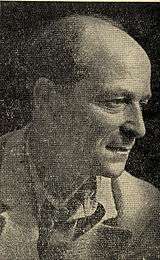Zikhron Ya'akov
Zikhron Ya'akov
| ||
|---|---|---|
| Hebrew transcription(s) | ||
| • ISO 259 | Zichron Yaˁaqob | |
| • Also spelled |
Zichron Ya'aqov (official) Zichron Yaakov (unofficial) | |
|
HaMeyasdim Street in Zikhron Ya'akov | ||
| ||
 Zikhron Ya'akov | ||
| Coordinates: 32°34′15″N 34°57′06″E / 32.57083°N 34.95167°ECoordinates: 32°34′15″N 34°57′06″E / 32.57083°N 34.95167°E | ||
| District | Haifa | |
| Founded | 1882 | |
| Government | ||
| • Type | Local council | |
| • Head of Municipality | Eli Abutbul | |
| Area | ||
| • Total | 32,129 dunams (32.129 km2 or 12.405 sq mi) | |
| Population (2015)[1] | ||
| • Total | 22,532 | |
| Name meaning | Jacob's Memorial | |

Zikhron Ya'akov (Hebrew: זִכְרוֹן יַעֲקֹב, lit. "Jacob's Memorial"; often shortened to just Zikhron; Arabic: زخرون يعكوف) is a town in Israel, 35 kilometres (22 mi) south of Haifa, and part of the Haifa District. It is located at the southern end of the Carmel mountain range overlooking the Mediterranean Sea, near the coastal highway (Highway 2). It was one of the first Jewish settlements of Halutzim in the country, founded in 1882 by Baron Edmond James de Rothschild and named in honor of his father, James Mayer de Rothschild.[2] In 2015 it had a population of 22,532.
History
Zikhron Ya'akov was founded in December 1882 when 100 Jewish pioneers from Romania, members of the Hovevei Zion movement, purchased land in Zammarin.[3] The difficulty of working the rocky soil and an outbreak of malaria led many of the settlers to leave before the year was up.[3]
In 1883, Baron Edmond James de Rothschild became the patron of the settlement and drew up plans for its residential layout and agricultural economy. Zikhron was one of the first Jewish agricultural colonies to come under the wing of the Baron (along with Rishon LeZion and Rosh Pinna), who renamed it in memory of his father, James (Ya'akov) Mayer de Rothschild.[2][3]
To accomplish his first objective, Baron de Rothschild brought in planners who designed and allotted housing lots along the main road for the use of settlement farmers. Each lot included a house facing the street, a long interior courtyard and a rear building for storing agricultural implements. The French-inspired architecture included tiled roofs and painted wooden windows. Each farmer was given a salary and placed under the direction of Elijah Shaid, the Baron's clerk. The Baron also commissioned the construction of the Ohel Ya'akov Synagogue, named after his father, to serve the town.[4] Sparing no expense to build the edifice, the synagogue features a majestic ark made of white marble. The synagogue opened in 1886 and has conducted daily prayer services continuously to this day.
Following a number of economic failures, in 1885 Rothschild helped to establish the first winery in Israel, Carmel Winery, together with a bottling factory, in Zikhron Ya'akov. This was more successful economically although it was initially short-lived as in 1892 the grapevines succumbed to phylloxera, a type of parasite. After a brief set-back, American seedlings which were resistant to phylloxera were grown and the winery began to flourish. Today, the winery remains in action, as do the huge wine cellars that were carved into the mountain over a century ago. In 1954, the remains of Baron Edmond de Rothschild were reinterred in Zikhron Ya'akov.
Nili spy ring
Zikhron Ya'akov came to fame during World War I for the establishment of the Nili spy ring by Sarah Aaronsohn, together with her brothers, Aaron (a noted botanist) and Alex, and their friend Avshalom Feinberg. The group volunteered to spy on Ottoman positions and report them to British agents offshore. In September 1917, the Ottomans caught one of Sarah's carrier pigeons and cracked the Nili code. In October, they surrounded Zikhron Ya'akov and arrested Sarah and several others. After four days of torture, they planned on transporting Sara elsewhere, she requested to be taken home to change her clothes and shot herself with a pistol hidden in her bathroom and died after several days. Sara shot herself in the throat, leaving her unable to speak, in order to avoid releasing classified information. The Aaronsohn House–Nili Museum recreates the history of this period.
Demographics
In the 1922 census of Palestine conducted by the British Mandate authorities, Zicron-Jacob had a population of 1,302 inhabitants; 1,013 Jews, 7 Christians and 282 Muslims,[5] where the Christians were 2 Orthodox, 3 Roman Catholics, 1 Anglican and 1 Protestant.[6]
The population increased dramatically in the early 1950s, after the establishment of the State of Israel. Between the 1960s and 1990s, the population remained constant with about 5,000 inhabitants. At the end of 2009, Zikhron Yaakov had a population of 18,719.[7] Many residents continue to engage in agriculture, although upscale private homes have been built by families attracted to the scenic landscape. Zikhron Ya'akov has a high amount of English speaking residents, olim and others. They amount to 20% of the moshava's population.
Education and religious institutions
While the vast majority of citizens of the town would define themselves as secular, there is a sizable religious Jewish community in the town, including Haredi members of the Ohr Yaakov Yeshiva and members of a Chabad-Lubavitch community. In addition there are several religious zionist synagogues. It is unique in that there are Progressive/Reform and Conservative Jewish communities and synagogues in Zikhron Ya'akov. The former, "Kehillat Sulam Yaakov" (in Hebrew "Jacob's Ladder Community") is a synagogue that practices Progressive Judaism and is a part of the Israeli Movement for Progressive Judaism. The latter, "VeAhavta", is a synagogue that practices Conservative Judaism.
Landmarks
The original Carmel-Mizrahi Winery continues to make wine in Zikhron Yaakov. The town draws many tourists attracted to its picturesque setting and historic city center whose restored main street of landmark buildings, called Derekh HaYayin ("Path of the Wine"), houses coffeehouses and boutique shops selling locally-made crafts, jewellery, and antiques, especially on the town's famous "Midrachov" (Rechov haMeyasdim — Founders Street).[3] It was announced in early 2008 that a 150-acre (0.61 km2) wine park would be created on the slope between Zikhron and neighboring town Binyamina.[8]
Notable residents
- David Remez
- Moshe Ivgy
- Aaron Ben-Ze'ev
- Motti Lerner
- Dan Shilon
- Reuven Gal
- Yair Naveh
- Chaim Dov Kantor
- Avi Mizrahi
- Sarah Aaronsohn
- Joseph Zaritsky (1891–1985), Israeli painter
International Relations
Twin towns — sister cities
Zikhron Ya'akov is twinned with:
 Maisons-Alfort, France
Maisons-Alfort, France Charenton-le-Pont, France
Charenton-le-Pont, France
See also
References
- ↑ "List of localities, in Alphabetical order" (PDF). Israel Central Bureau of Statistics. Retrieved 16 October 2016.
- 1 2 "Zichron Yaakov". Retrieved 2008-01-26.
- 1 2 3 4 "Gems in Israel-Zichron Ya'acov". Gems in Israel. Retrieved 2008-01-26.
- ↑ Ya'akov offers breathtaking views, history lesson
- ↑ Barron, 1923, Table XI, Sub-district of Haifa, p. 34
- ↑ Barron, 1923, Table XVI, p. 49
- ↑ "List of Localities" (PDF) (in Hebrew and English). The Israeli Central Bureau of Statistics. 31 December 2009. p. 10. Retrieved 12 July 2011.
- ↑ "Israel seeks to become wine tourism destination". Globes. 2008-01-17. Retrieved 2008-01-17.
Bibliography
- Barron, J. B., ed. (1923). Palestine: Report and General Abstracts of the Census of 1922. Government of Palestine.
External links
| Wikimedia Commons has media related to Zichron Yaacov. |
- History of Zikhron Ya'aqov
- Places To Visit in Zikhron Ya'akov (English)
- Photos of Restoration of Historic Zikhron Ya'akov Project



